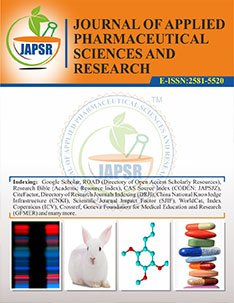A RETROSPECTIVE STUDY ON PREVALENCE OF INFERTILITY IN WOMEN OF DELHI NATIONAL CAPITAL REGION
Abstract
According to WHO infertility is primary if there is failure of conception despite two years of cohabitation while it is secondary if a
couple fails to conceive following a previous pregnancy, despite two years of cohabitation and exposure to pregnancy (in the absence of
contraception, breastfeeding or postpartum amenorrhea). Objective: This study helps to evaluate the possible reasons of primary as well as
secondary infertility in rural and urban areas of Delhi NCR, India. Material & Method: 521 women were screened and included in the study
having history of either type of infertility. Results and Discussion: Amongst many valid reasons for infertility in women some new findings,
although not significant, but may be a possible use of NSAIDs (5.56%) for one or other reason which may disturb normal ovulation cycle or
process of ovulation. 7.86% women were suffering from PCOS, 52.19% women with case of tube blockage due to genital or other form of
tuberculosis or Sexually Transmitted Infections, STIs. Hyperprolactinemia and hypothyroidism, which affected 34.35% females are some
another factors for such a high incidence of infertility in this region. Conclusion: This study provides an insight view for major causes of
infertility. Primary infertility with genital infection led tube blockage is one the leading factor for female infertility in Delhi NCR.
Downloads
All the articles published in JAPSR are distributed under a creative commons license (CC BY-NC-SA 4.0)
Under this license, you are free to:
- Share- copy and redistribute the material in any medium or format for any purpose, even commercially.
- Adapt- remix, transform, and build upon the material for any purpose, even commercially.
The licensor cannot revoke these freedoms as long as you follow the license terms.
- Attribution — You must give appropriate credit , provide a link to the license, and indicate if changes were made . You may do so in any reasonable manner, but not in any way that suggests the licensor endorses you or your use.
- NonCommercial — You may not use the material for commercial purposes .
- ShareAlike — If you remix, transform, or build upon the material, you must distribute your contributions under the same license as the original.
- No additional restrictions — You may not apply legal terms or technological measures that legally restrict others from doing anything the license permits.
Copyright policy
The journal allows the author(s) to hold the copyright of their work. That means the authors do not need to transfer the copyright of their work to the journal. However, the authors grant JAPSR a license to publish the article and identify itself as the original publisher.
Licensing policy
The journal allows the author(s) to hold the copyright of their work. That means the authors do not need to transfer the copyright of their work to the journal. However, the authors grant JAPSR a license to publish the article and identify itself as the original publisher.






